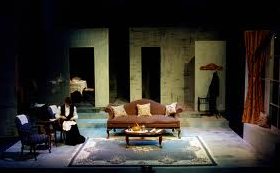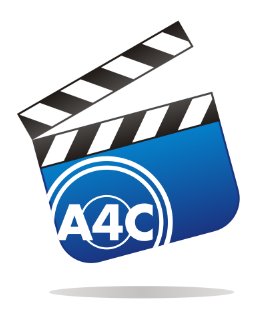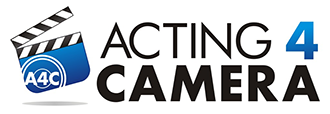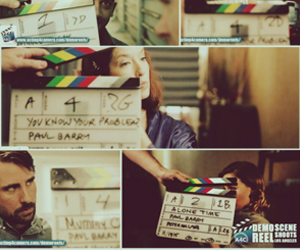By Paul Barry
 See Stage vs Screen (Part One) here.
See Stage vs Screen (Part One) here.
I began directing at the age of seventeen. My directorial debut, The Problem, by A.R. Gurney Jnr, had a cast of two much older actors than me. I designed the ‘set’ using the fallback principle of all low/no-budget theatre: simplified realism. An old armchair sat slightly stage left, a small bookcase on one side and a lamp on the other. The whole scene sat atop a Persian rug, nestled within in a cozy pool of light with about a four foot radius, leaving details I couldn’t afford to purchase or source to the audience’s imagination. (‘Don’t draw attention to what you don’t have’ remains one of the best pieces of advice I ever received as a director). The play began with a ‘normal’ couple discussing what to do about her ‘problem’, which was her enormous pregnant belly, after which the play gradually devolved into the debauched and the politically incorrect. ‘Increasingly complex Arabesques of sexual perversion’, as they said in the play. Wrong in so many ways, but terribly funny.
At university we alternated between performing in three theatres – an old pro-arch stage, a community theatre and a small cobbled-together experimental black box studio. Each venue had pros and cons, but each also had its own character. Audiences definitely responded differently in each separate space too, which was worth taking into consideration during the rehearsal process. The Problem was staged in the big pro-arch theatre, which made sound an issue, an issue that never arose in the smaller studio. We had plenty of room to move in this theatre but plays in the studio were quite cramped. It became apparent to me at the age of seventeen that there was important differences between the performances I needed to create depending on the stage. I directed this play with no understanding of encouraging blocking in realistic three-dimensions, it was all ‘play it out to the audience’, ‘turn it out’ and ‘play it to the back row’. I was seventeen and it was 1991. I find it harder to forgive middle-aged directors who continue to direct this way in 2012.
Jump forward six years and I had graduated from UNE and NIDA and now walked onto my first proper TV set. The 1st AD called for a rehearsal and I was surprised by the large number of crewmembers assembling to listen to a read through of the scene. Here I was thinking we only had an audience on stage! I launched into my performance, but my scene partner seems to be giving me nothing. Ensuring everyone in the room could clearly hear what I was saying and see what I’m doing, he was almost mumbling to himself. The first line he delivered took me so off-guard that I didn’t even realize he had begun, but I bravely continued, strong in the faith that someone would tell him to start acting soon enough. I later discovered that I didn’t know my fellow actor was acting because he was simply behaving like a real human being. A skill I hadn’t, up to that point (and perhaps even now), mastered….
 I soon began to realize that the major difference between stage and camera had little to do with size and much to do with believability. Upon making this discovery I began to ponder the ramifications of that concept. If I was right, then logically, it meant that the elements that built an acceptable performance on screen could be boiled down to ‘believability’, and by contrast, stage was largely boiled down to ‘fakery’. This, I downright refused to accept. Truth, I opined, has as much of a home on stage as on screen, just as seemingly unnatural technical considerations have a necessary place on a film or television set. I set about defining the similarities and differences in an attempt to solidify a methodology for transitioning seamlessly between the two mediums.
I soon began to realize that the major difference between stage and camera had little to do with size and much to do with believability. Upon making this discovery I began to ponder the ramifications of that concept. If I was right, then logically, it meant that the elements that built an acceptable performance on screen could be boiled down to ‘believability’, and by contrast, stage was largely boiled down to ‘fakery’. This, I downright refused to accept. Truth, I opined, has as much of a home on stage as on screen, just as seemingly unnatural technical considerations have a necessary place on a film or television set. I set about defining the similarities and differences in an attempt to solidify a methodology for transitioning seamlessly between the two mediums.
I began to create allegiances with crew members of plays, TV shows and films that I worked on. I would interrogate the director, DOP, script supervisor and editor of each screen job I took, whilst absorbing every ounce of data I could from set, lighting and costume designers of stage productions. After years of learning what I could from the crews around me in shows, I recommenced directing for stage and commenced directing for screen. I soon took up writing for both as well, which added an entirely new dimension to my understanding of the considerations one makes for stage and screen long before a director even enters the picture, let alone the actors. The choice of performance venue can have so much influence on the writing and yet few writers will ever know the details of the venue’s ‘character’ and dimensions before it is close to being staged. Even less, about how the audience will respond if it is a small crowd versus a full house. I have discovered that many problems actors experience on stage and screen can quite simply be solved in the writing phase. So for now, despite the many other issues to tackle, let’s just briefly touch on writing.
Some writing, be it for stage or screen, does not call for much physical movement. Other scripts fill pages with mountains of stage direction and big print, in plays and films respectively. I’m sure we’ve all seen films where we felt there was too much movement, similarly here is a production of The Problem on Youtube (not mine) to see what happens when people stage a production and feel the need to arbitrarily ‘use the space’, without considering for a second what may motivate them to get up in the first place. Sure, we’ve all been told ‘you need a reason to move’ or even asked a director: ‘what’s my motivation?’ when they have suggested you walk to the window, but the final test of it all is whether the audience believes it. Sadly, watching the Youtube clip, I do not believe a single movement or utterance of either actor. But I did when my actors performed in front of me as a seventeen year-old director. Why? Because they were believable.
In part three I will delve more into the mechanics of what it is to be believable on stage and screen, as well as fleshing out the lessons I learned from screen and stage crews over the years….
Paul Barry is an actor, director, writer, teacher and blogger. He co-owns Acting 4 Camera and Showreels Australia. He lives in LA, but regularly teaches via Skype, all around the world.
(The blogs you see on www.acting4camera.com are free, but they don’t write themselves. If you find the information useful, feel free to donate below to keep them coming. Your contribution of any amount is graciously welcomed!)








Follow Us!